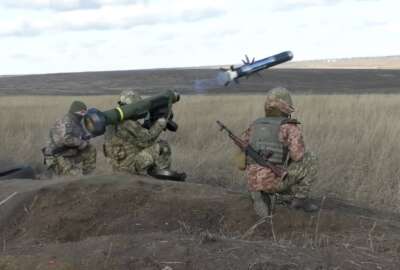Contractors are eyeing possible passage of a big aid-to-Ukraine bill
The Senate could vote tomorrow on a $40 billion military aid package for Ukraine. It's already passed the House. Whatever happens, it will require contracts and...
Best listening experience is on Chrome, Firefox or Safari. Subscribe to Federal Drive’s daily audio interviews on Apple Podcasts or PodcastOne.
The Senate could vote tomorrow on a $40 billion military aid package for Ukraine. It’s already passed the House. Whatever happens, it will require contracts and contractors. Joining the Federal Drive with Tom Temin with a look inside, the executive vice president for policy at the Professional Services Council, Stephanie Kostro.
Interview transcript:
Tom Temin: And let’s start with well, what’s in that bill for contractors should this somehow get enacted?
Stephanie Kostro: Good morning, Tom, and thanks for so much for having me. This Ukraine supplemental bill is in addition to the $13.6 billion Ukraine supplemental that was included in the FY 22 appropriations bills. What’s amazing to me, unpacking this new Ukraine supplemental the president in the White House asked for $33 billion. The House increased that amount when they voted last week to $40 billion. I’m curious to see what the Senate votes on, I would suspect it will be the larger package without much in the way of changing. The numbers tells me that a lot of this is going towards Ukraine security assistance initiative, the USAI that is the initiative to arm both with lethal and non-lethal weapons, Ukrainian Security Forces, that’s about $6 billion. But there is also a larger number out there in the House bill, there was $9 billion for replenishment of U.S. stocks, and that’s to use draw down authority to help replenish those weapons that have either been used or otherwise given to the Ukrainians in defense of their country.
Tom Temin: So now that answers the question of where this is coming from, it is our inventories for warmaking that have been sent over there. And we’ve got to keep our own powder not only dry, but also at the levels we feel safe about.
Stephanie Kostro: That’s very true, Tom, according to some think tank estimates we had about 20,000 Javelins in stock available for use, and we are transferring them at a higher rate, much higher rate than we are producing them every year, my understanding is that we can produce 2,100 Javelins per year. And we’ve been transferring them to Ukraine at a rate of 2,500 per month, so roughly 5,000 javelins over to Ukraine. And that is not sustainable, as you can imagine.
Tom Temin: Right. So then this money that would be in the appropriations would be acquisition money to replenish our stocks is that the color of money that they’re talking about?
Stephanie Kostro: My understanding is that the $9 billion is procurement money so that they can procure Stingers, Javelins and other weapons that we are using, or at least transferring over to Ukraine for their use. I would say that there is some operations and maintenance money involved as well for the missiles that we are providing and that the missiles that we have in inventory. So there are two separate colors of money here, both operations and maintenance and procurement. And those come with different reporting requirements and lead times. We’re hopeful that contracts might be signed in the very near term, to increase production to get those things off the production line. You know, the president visited Alabama earlier this month and went to a production facility for Javelins. Unfortunately, I didn’t see any reporting that any contracts had been signed. And I’m hopeful that those are in the offing in the near future, as well as for Stingers.
Tom Temin: Is the Javelin a sole source product?
Stephanie Kostro: At this point, it is a cooperative effort between two companies. And so my understanding is that this is the facility, this is the partnership that we were focusing on.
Tom Temin: The question then is that 2,100 a year, normally sustainable production rate, the decision must be made, do we need to increase that? And then how is that possible?
Stephanie Kostro: And it takes quite a while. I mean, if you hear some of the reports in the media, that increasing production is not exactly like you’re adding just all of the inputs, and all of a sudden, you can bump it up at the output level, it takes years to get those production lines as hot as they need to be to get the source materials for these missiles and this equipment. And I think we’re gonna see it take a few years to get them up past the normal rate of production. And so any funding that can go towards that would be very helpful at this time.
Tom Temin: And these are not real big objects. I mean, it’s something you could pick up in your two arms.
Stephanie Kostro: Yeah, some of these are manned portable, and they can be deployed. We’ve seen the media reports, right of the Ukrainians using these weapons to great effect, whether it’s taking out a tank, or otherwise, just intimidating the Russian forces. And I think at the end of the day, this is going to be a set of equipment that we find real value in going forward. It’s just getting those production lines going.
Tom Temin: We’re speaking with Stephanie Kostro, executive vice president for policy at the Professional Services Council. And that’s a good segue into a nominated person to become Assistant Secretary of Defense for the Supply Base and Supply Chain. There’s a nomination it’s not confirmed yet. It’s a whole new position, who’s nominated and what will they face if they get confirmed?
Stephanie Kostro: That is a great question. The White House announced its intent to nominate Dr. Laura Taylor-Kale for this position, Assistant Secretary of Defense for Industrial Base Policy, Congress elevated this position from a deputy assistant secretary position, which means the position holder needs to be confirmed by the Senate. Dr. Taylor-Kale is well known to this community and had worked in the Obama administration as a Commerce official. She has focused a lot on innovation, economic dynamics, I think that will be refreshing. What I’m looking for. I mean, what community is looking for from a services contractor perspective, is how well does she understand profit and loss? How well does she understand the business side of industrial base policy? You’ll recall that in February, the Pentagon put out a report on competition. And, you know, that’s been talked about quite a bit in the media and on Capitol Hill in hearings. I’m curious as to what Dr. Taylor-Kale might have to say about what she thinks the level of competitiveness is within the defense industrial base. Part of that will be small businesses, and there has been a real push with the Biden-Harris administration. And in DoD coming up with a small business strategy. I am very curious to see what she thinks about midsized companies, those who have moved on to other than small status, I think, what does she want to see, what innovations can she see coming out of that, and I think supply chain resilience is the other thing that she might need to focus on. I understand they have a new position, looking specifically at supply chain resilience at the Pentagon, and we’re looking forward to working with that individual.
Tom Temin: Competition begets competition, you know, this is what we’re seeing, say, in the baby formula market, you know, to look at another domain for a moment, because so much of the federal spending for formula is concentrated on one or two manufacturers, and therefore, there’s no incentive for people to join the competition. So it’s a complicated mixture.
Stephanie Kostro: It is a complicated mixture. I think one key differentiator other than the obvious between baby formula and defense is that the real market for equipment in defense and national security is the Department of Defense. It determines the market, whereas baby formula, you’ve got lots of buyers and consumers across the spectrum and around the world. And so I think the Industrial Base Policy Office really needs to take a good look at its role as the principal customer for defense services and defense products, and figure out how to work with industry and have a good dialogue about how they look at the market in their different ways, you know, not necessarily profit and loss, but effectiveness. But they all you know, we want to work together for the greater good. It’s just understanding each other’s perspectives. And when we’ve got something like the competition report that came out in February, that sort of lays all of the blame and responsibility at the foot of defense industry without acknowledging that the Defense Department is for all intents and purposes, the sole customer, it’s a real problem.
Tom Temin: All right, well, we’ll hope if she’s confirmed, she can figure that one out, because it’s not an easy one. And nobody will be totally happy with how the answers come. And a final question. There’s a movement coming in NATO, the Madrid Summit, which is the end of next month, and that could draw in some contractors also?
Stephanie Kostro: What’s interesting about the Madrid Summit, and I’m speaking as someone who used to work at U.S. NATO and understanding the dynamics of an alliance that has currently I’ll say, currently 30 allies in it. You know, they talk about what the force posture will look like throughout Europe. And in speaking to my Army colleagues, one question is how many brigade combat teams will be stationed in Eastern Europe say, Poland or the Baltic states, Latvia, Lithuania and Estonia, in light of Russian aggression. And I think that will be on the table for the Madrid Summit. What I will be looking for from a, you know, services contractor perspective, is what do the lines of communication look like? What are the resupply lines? What are the sustainment challenges that you might face in Poland and the Baltic states? And how can contractors contribute to that? So while we were watching that closely,
Tom Temin: Stephanie Kostro is executive vice president for policy at the Professional Services Council. As always, thanks so much.
Stephanie Kostro: Thanks, Tom.
Copyright © 2024 Federal News Network. All rights reserved. This website is not intended for users located within the European Economic Area.
Tom Temin is host of the Federal Drive and has been providing insight on federal technology and management issues for more than 30 years.
Follow @tteminWFED






